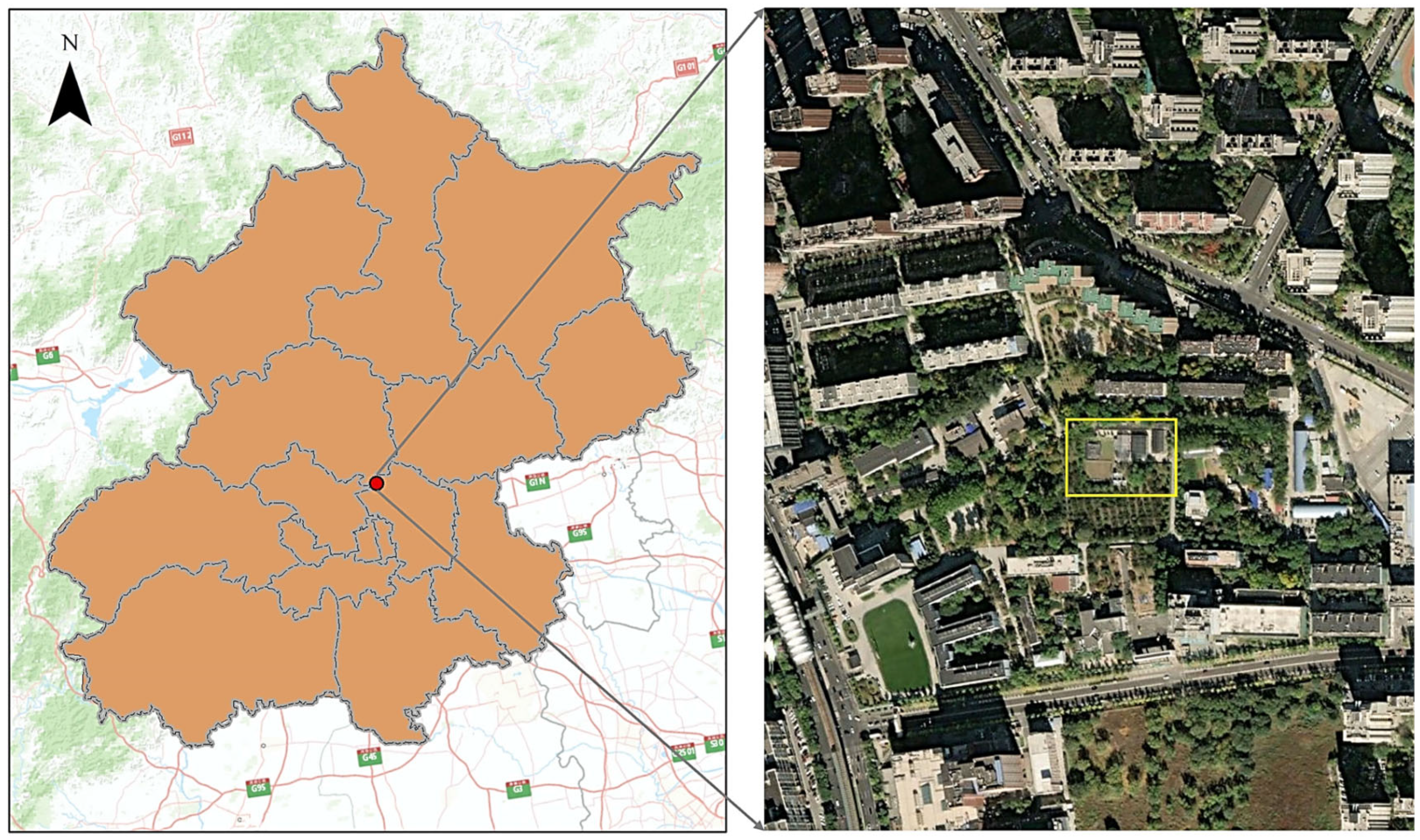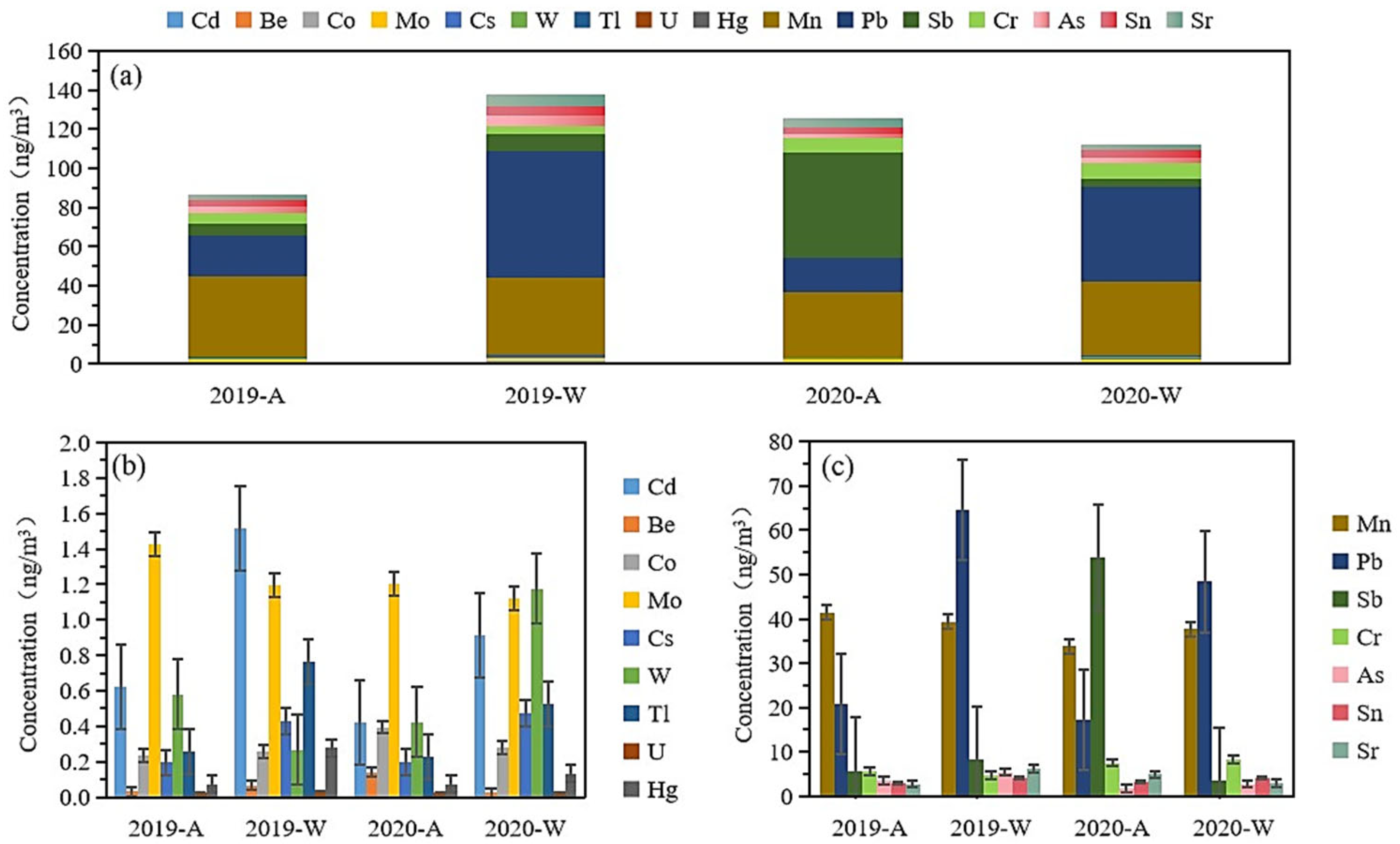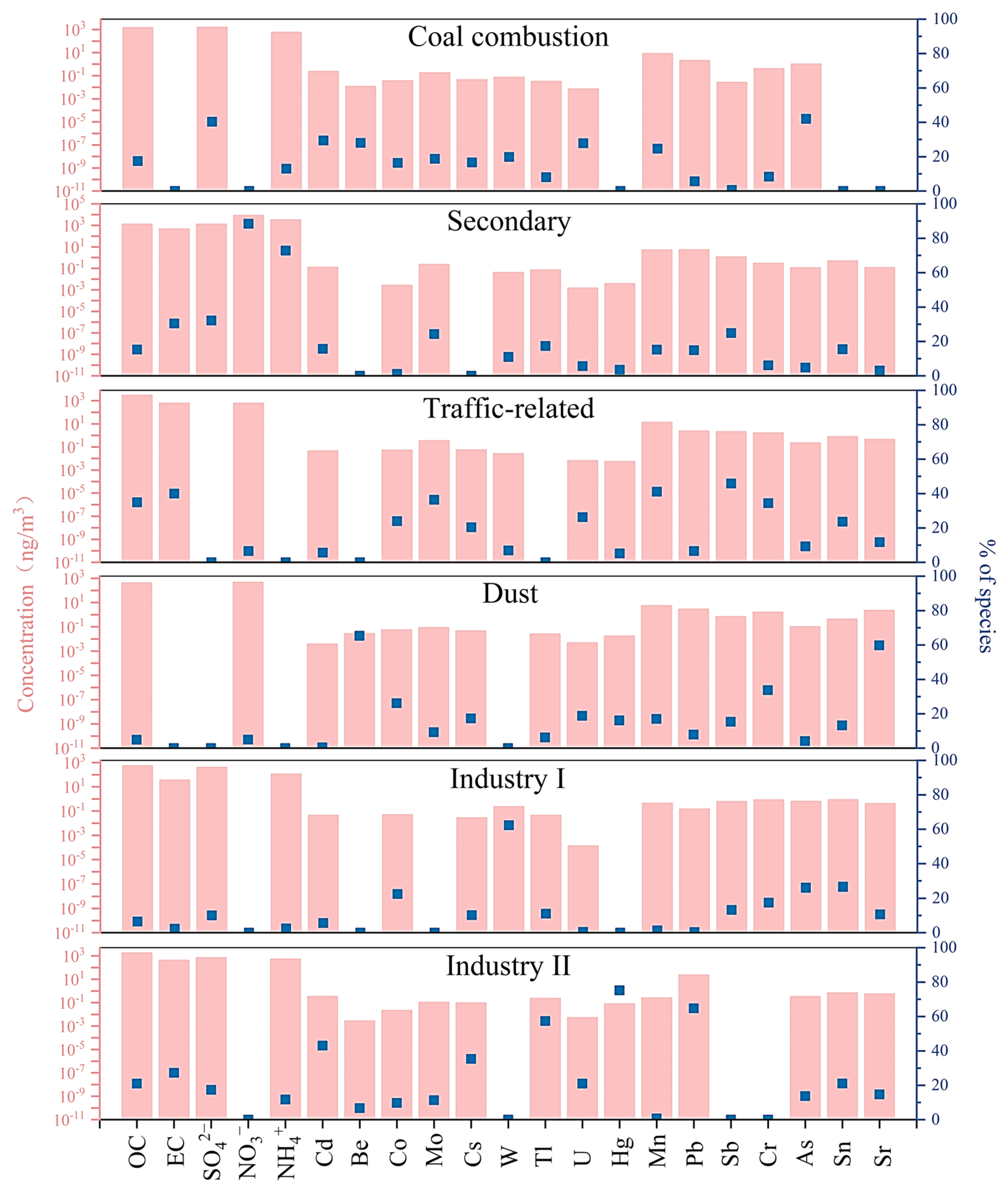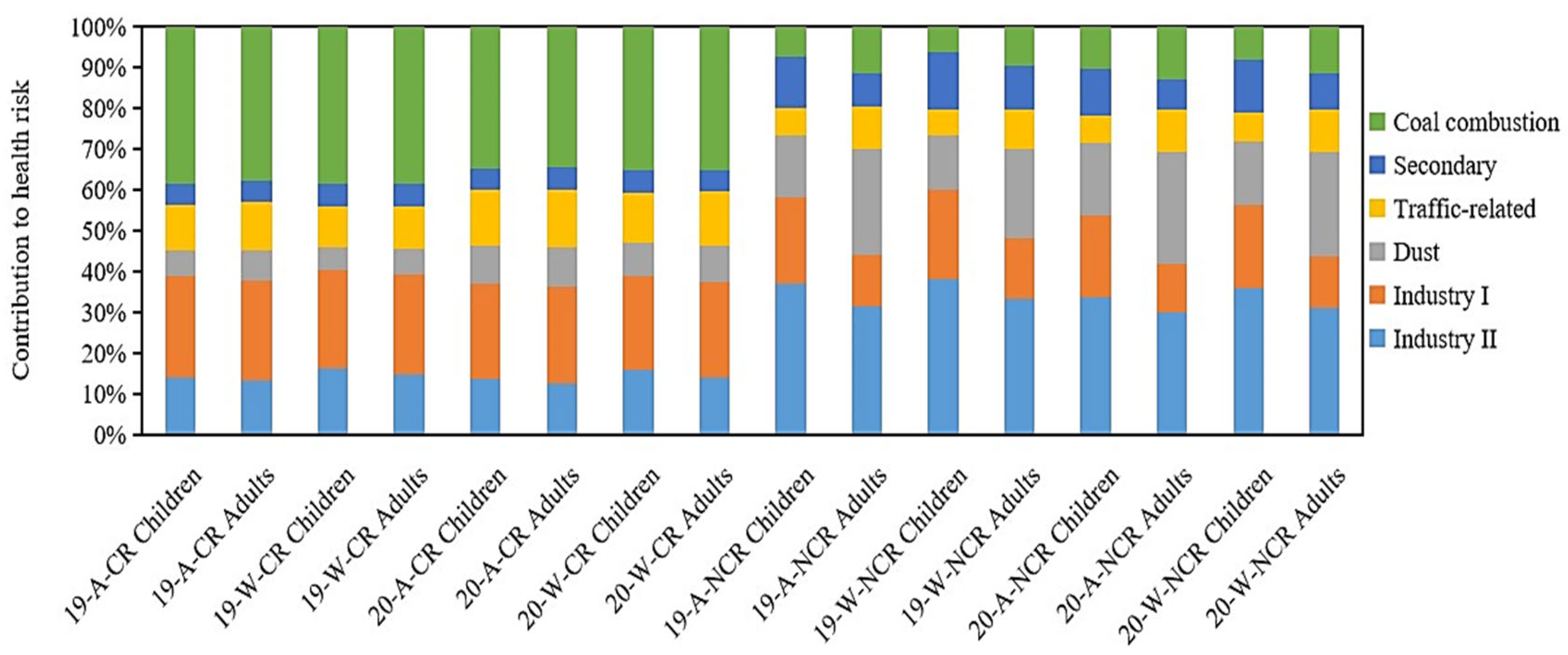Exploring Sources and Health Risks in Beijing PM2.5 in 2019 and 2020
Abstract
1. Introduction
2. Materials and Methods
2.1. Study Area and Sampling
2.2. Chemical Analysis
2.3. Backward Trajectory
2.4. Positive Matrix Factorization (PMF) Model
2.5. Health Risk Assessment
3. Results and Discussion
3.1. PM2.5 Mass Concentrations
3.2. Source Analysis
3.3. Health Risk Assessment
4. Conclusions
Supplementary Materials
Author Contributions
Funding
Acknowledgments
Conflicts of Interest
References
- Liu, Y.; Zhan, J.; Zheng, F.; Song, B.; Zhang, Y.; Ma, W.; Hua, C.; Xie, J.; Bao, X.; Yan, C.; et al. Dust emission reduction enhanced gas-to-particle conversion of ammonia in the North China Plain. Nat. Commun. 2022, 13, 6887. [Google Scholar] [CrossRef] [PubMed]
- Li, H.; Hart, J.E.; Mahalingaiah, S.; Nethery, R.C.; Bertone-Johnson, E.; Laden, F. Long-term exposure to particulate matter and roadway proximity with age at natural menopause in the Nurses’ Health Study II Cohort. Environ. Pollut. 2021, 269, 116216. [Google Scholar] [CrossRef] [PubMed]
- Li, J.; Mao, M.; Li, J.; Chen, Z.; Ji, Y.; Kong, J.; Wang, Z.; Zhang, J.; Wang, Y.; Liang, W.; et al. Oral Administration of Omega-3 Fatty Acids Attenuates Lung Injury Caused by PM2.5 Respiratory Inhalation Simply and Feasibly In Vivo. Int. J. Mol. Sci. 2022, 23, 5323. [Google Scholar] [CrossRef] [PubMed]
- Gouveia, N.; Kephart, J.L.; Dronova, I.; McClure, L.; Granados, J.T.; Betancourt, R.M.; O’Ryan, A.C.; Texcalac-Sangrador, J.L.; Martinez-Folgar, K.; Rodriguez, D.; et al. Ambient fine particulate matter in Latin American cities: Levels, population exposure, and associated urban factors. Sci. Total Environ. 2021, 772, 145035. [Google Scholar] [CrossRef]
- Wang, Q.; Wang, J.; He, M.Z.; Kinney, P.L.; Li, T. A county-level estimate of PM2.5 related chronic mortality risk in China based on multi-model exposure data. Environ. Int. 2018, 110, 105–112. [Google Scholar] [CrossRef]
- Shen, G.; Tao, S.; Wei, S.; Zhang, Y.; Wang, R.; Wang, B.; Li, W.; Shen, H.; Huang, Y.; Chen, Y.; et al. Emissions of parent, nitro, and oxygenated polycyclic aromatic hydrocarbons from residential wood combustion in rural China. Environ. Sci. Technol. 2012, 46, 8123–8130. [Google Scholar] [CrossRef]
- Rogula-Kozłowska, W. Size-segregated urban particulate matter: Mass closure, chemical composition, and primary and secondary matter content. Air Qual. Atmos. Health 2016, 9, 533–550. [Google Scholar] [CrossRef]
- Chow, J.C.; Lowenthal, D.H.; Chen, L.W.; Wang, X.; Watson, J.G. Mass reconstruction methods for PM2.5: A review. Air Qual. Atmos. Health 2015, 8, 243–263. [Google Scholar] [CrossRef]
- Liang, Y.; Fang, L.; Pan, H.; Zhang, K.; Kan, H.; Brook, J.R.; Sun, Q. PM2.5 in Beijing—Temporal pattern and its association with influenza. Environ. Health 2014, 13, 102. [Google Scholar] [CrossRef]
- Rogula-Kozłowska, W.; Klejnowski, K.; Rogula-Kopiec, P.; Ośródka, L.; Krajny, E.; Błaszczak, B.; Mathews, B. Spatial and seasonal variability of the mass concentration and chemical composition of PM2.5 in Poland. Air Qual. Atmos. Health 2014, 7, 41–58. [Google Scholar] [CrossRef]
- Fan, M.Y.; Zhang, Y.L.; Lin, Y.C.; Cao, F.; Sun, Y.L.; Qiu, Y.M.; Xing, G.H.; Dao, X.; Fu, P.Q. Specific sources of health risks induced by metallic elements in PM2.5 during the wintertime in Beijing, China. Atmos. Environ. 2021, 246, 1352–2310. [Google Scholar] [CrossRef]
- Tchounwou, P.B.; Yedjou, C.G.; Patlolla, A.K.; Sutton, D.J. Heavy metal toxicity and the environment. Exp. Suppl. 2012, 101, 133–164. [Google Scholar] [CrossRef] [PubMed]
- Hsu, C.Y.; Chiang, H.C.; Lin, S.L.; Chen, M.J.; Lin, T.Y.; Chen, Y.C. Elemental characterization and source apportionment of PM10 and PM2.5 in the western coastal area of central Taiwan. Sci. Total Environ. 2016, 541, 1139–1150. [Google Scholar] [CrossRef] [PubMed]
- Chinese Government News. 2019. Available online: http://www.gov.cn/xinwen/2019-02/05/content_5364004.htm (accessed on 15 August 2020).
- Choi, E.; Yi, S.M.; Lee, Y.S.; Jo, H.; Baek, S.O.; Heo, J.B. Sources of airborne particulate matter-bound metals and spatial-seasonal variability of health risk potentials in four large cities, South Korea. Environ. Sci. Pollut. Res. Int. 2022, 29, 28359–28374. [Google Scholar] [CrossRef] [PubMed]
- Lee, Y.S.; Kim, Y.K.; Choi, E.; Jo, H.; Hyun, H.; Yi, S.M.; Kim, J.Y. Health risk assessment and source apportionment of PM2.5-bound toxic elements in the industrial city of Siheung, Korea. Environ. Sci. Pollut. Res. Int. 2022, 29, 66591–66604. [Google Scholar] [CrossRef]
- Guo, Y.; Li, S.; Zhang, L.; Xuan, Q.; He, L.; Ye, Q.; Ma, J.; Peng, L.; Xiong, Y.; Yang, J.; et al. Depression and anxiety of medical students at Kunming Medical University during COVID-19: A cross-sectional survey. Front. Public Health 2022, 10, 957597. [Google Scholar] [CrossRef]
- Wang, S.; Chen, L.; Ran, H.; Che, Y.; Fang, D.; Sun, H.; Peng, J.; Liang, X.; Xiao, Y. Depression and anxiety among children and adolescents pre and post COVID-19: A comparative meta-analysis. Front. Psychiatry 2022, 13, 917552. [Google Scholar] [CrossRef]
- Piubelli, C.; Deiana, M.; Pomari, E.; Silva, R.; Bisoffi, Z.; Formenti, F.; Perandin, F.; Gobbi, F.; Buonfrate, D. Overall decrease in SARS-CoV-2 viral load and reduction in clinical burden: The experience of a hospital in northern Italy. Clin. Microbiol. Infect. 2021, 27, 131.e1–131.e3. [Google Scholar] [CrossRef]
- Shen, F.; Hegglin, M.I.; Luo, Y.; Yuan, Y.; Wang, B.; Flemming, J.; Wang, J.; Zhang, Y.; Chen, M.; Yang, Q.; et al. Disentangling drivers of air pollutant and health risk changes during the COVID-19 lockdown in China. npj Clim. Atmos. Sci. 2022, 5, 54. [Google Scholar] [CrossRef]
- Zhang, Y.; Wu, W.; Li, Y.; Li, Y. An investigation of PM2.5 concentration changes in Mid-Eastern China before and after COVID-19 outbreak. Environ. Int. 2023, 175, 107941. [Google Scholar] [CrossRef]
- Kerimray, A.; Baimatova, N.; Ibragimova, O.P.; Bukenov, B.; Kenessov, B.; Plotitsyn, P.; Karaca, F. Assessing air quality changes in large cities during COVID-19 lockdowns: The impacts of traffic-free urban conditions in Almaty, Kazakhstan. Sci. Total Environ. 2020, 730, 139179. [Google Scholar] [CrossRef] [PubMed]
- Bar, S.; Parida, B.R.; Mandal, S.P.; Pandey, A.C.; Kumar, N.; Mishra, B. Impacts of partial to complete COVID-19 lockdown on NO2 and PM2.5 levels in major urban cities of Europe and USA. Cities 2021, 117, 103308. [Google Scholar] [CrossRef]
- Gulyaev, E.; Antonov, K.; Markelov, Y.; Poddubny, V.; Shchelkanov, A.; Iurkov, I. Short-term effect of COVID-19 lockdowns on atmospheric CO2, CH4 and PM2.5 concentrations in urban environment. Int. J. Environ. Sci. Technol. 2023, 20, 4737–4748. [Google Scholar] [CrossRef] [PubMed]
- Nguyen, G.T.H.; Hoang-Cong, H.; La, L.T. Statistical Analysis for Understanding PM2.5 Air Quality and the Impacts of COVID-19 Social Distancing in Several Provinces and Cities in Vietnam. Water Air Soil Pollut. 2023, 234, 85. [Google Scholar] [CrossRef] [PubMed]
- Wang, S.S.; Hu, G.R.; Yu, R.L.; Shen, H.Z.; Yan, Y. Bioaccessibility and source-specific health risk of heavy metals in PM2.5 in a coastal city in China. Environ. Adv. 2021, 4, 100047. [Google Scholar] [CrossRef]
- Chen, G.; Tao, J.; Wang, J.; Dong, M.; Li, X.; Sun, X.; Cheng, S.; Fan, J.; Ye, Y.; Xiao, J.; et al. Reduction of air pollutants and associated mortality during and after the COVID-19 lockdown in China: Impacts and implications. Environ. Res. 2021, 200, 111457. [Google Scholar] [CrossRef]
- Etchie, T.O.; Etchie, A.T.; Jauro, A.; Pinker, R.T.; Swaminathan, N. Season, not lockdown, improved air quality during COVID-19 State of Emergency in Nigeria. Sci. Total Environ. 2021, 768, 145187. [Google Scholar] [CrossRef]
- Wang, S.S.; Hu, G.R.; Yan, Y.; Wang, S.; Yu, R.L.; Cui, J.Y. Source apportionment of metal elements in PM2.5 in a coastal city in Southeast China: Combined Pb-Sr-Nd isotopes with PMF method. Atmos. Environ. 2019, 198, 302–312. [Google Scholar] [CrossRef]
- Chalbot, M.G.; Chitranshi, P.; da Costa, G.G.; Pollock, E.; Kavouras, I.G. Characterization of water-soluble organic matter in urban aerosol by 1 H-NMR spectroscopy. Atmos. Environ. 2016, 128, 235–245. [Google Scholar] [CrossRef]
- Norris, G.; Duvall, R.; Brown, S.; Bai, S. EPA Positive Matrix Factorization (PMF) 5.0 Fundamentals and User Guide; EPA/600/R-614/108 (NTIS PB2015-105147); U.S. Environmental Protection Agency: Washington, DC, USA, 2014.
- Motesaddi Zarandi, S.; Shahsavani, A.; Khodagholi, F.; Fakhri, Y. Concentration, sources and human health risk of heavy metals and polycyclic aromatic hydrocarbons bound PM2.5 ambient air, Tehran, Iran. Environ. Geochem. Health 2019, 41, 1473–1487. [Google Scholar] [CrossRef]
- U.S. EPA. Risk Assessment Guidance for Superfund. In Part A: Human Health Evaluation Manual; Part E, Supplemental Guidance for Dermal Risk Assessment; Part, vol. I. F, Supplemental Guidance for Inhalation Risk Assessment. 2011. Available online: http://www.epa.gov/oswer/riskassessment/human_health_exposure.htm (accessed on 18 July 2022).
- U.S. EPA. The Screening Level (RSL) Tables (last updated June 2011). 2011. Available online: http://www.epa.gov/region9/superfund/prg/index.html (accessed on 18 July 2022).
- U.S. EPA. User’s Guide and Background Technical Document for US EPA Region 9’s Preliminary Remediation Goals (PRG) Table. 2011. Available online: http://www.epa.gov/reg3hwmd/risk/human/rb-concentrationtable/usersguide.htm (accessed on 18 July 2022).
- Birbeck, J.A.; Westrick, J.A.; O’Neill, G.M.; Spies, B.; Szlag, D.C. Comparative Analysis of Microcystin Prevalence in Michigan Lakes by Online Concentration LC/MS/MS and ELISA. Toxins 2019, 11, 13. [Google Scholar] [CrossRef] [PubMed]
- Park, E.J.; Kim, D.S.; Park, K. Monitoring of ambient particles and heavy metals in a residential area of Seoul, Korea. Environ. Monit. Assess. 2008, 137, 441–449. [Google Scholar] [CrossRef]
- Zhang, Z.; Zhang, X.; Gong, D.; Quan, W.; Zhao, X.; Ma, Z.; Kim, S. Evolution of surface O3 and PM2.5 concentrations and their relationships with meteorological conditions over the last decade in Beijing. Atmos. Environ. 2015, 108, 67–75. [Google Scholar] [CrossRef]
- Huang, X.; Liu, Z.; Zhang, J.; Zhang, J.K.; Wen, T.X.; Ji, D.S.; Wang, Y.S. Seasonal variation and secondary formation of size-segregated aerosol water-soluble inorganic ions during pollution episodes in Beijing. Atmos. Res. 2016, 168, 70–79. [Google Scholar] [CrossRef]
- Lim, H.J.; Turpin, B.J. Origins of primary and secondary organic aerosol in Atlanta: Results of time-resolved measurements during the Atlanta Supersite Experiment. Environ. Sci. Technol. 2002, 36, 4489–4496. [Google Scholar] [CrossRef]
- Duan, J.; Tan, J. Atmospheric heavy metals and Arsenic in China: Situation, sources and control policies. Atmos. Environ. 2013, 74, 93–101. [Google Scholar] [CrossRef]
- Wang, X.Q.; Duan, W.J.; Zhu, J.X.; Wei, W.; Cheng, S.Y.; Mao, S.S. Nonlinear influence of winter meteorology and precursor on PM2.5 based on mathematical and numerical models: A COVID-19 and Winter Olympics case study. Atmos. Environ. 2022, 278, 119072. [Google Scholar] [CrossRef]
- Huang, H.; Jiang, Y.; Xu, X.; Cao, X. In vitro bioaccessibility and health risk assessment of heavy metals in atmospheric particulate matters from three different functional areas of Shanghai, China. Sci. Total Environ. 2018, 610–611, 546–554. [Google Scholar] [CrossRef]
- Lv, Z.; Wang, X.; Deng, F.; Ying, Q.; Archibald, A.T.; Jones, R.L.; Ding, Y.; Cheng, Y.; Fu, M.; Liu, Y.; et al. Source-Receptor Relationship Revealed by the Halted Traffic and Aggravated Haze in Beijing during the COVID-19 Lockdown. Environ. Sci. Technol. 2020, 54, 15660–15670. [Google Scholar] [CrossRef]
- Wu, J.; Bei, N.; Hu, B.; Liu, S.; Wang, Y.; Shen, Z.; Li, X.; Liu, L.; Wang, R.; Liu, Z.; et al. Aerosol-photolysis interaction reduces particulate matter during wintertime haze events. Proc. Natl. Acad. Sci. USA 2020, 117, 9755–9761. [Google Scholar] [CrossRef]
- Lai, A.; Lee, M.; Carter, E.; Chan, Q.; Elliott, P.; Ezzati, M.; Kelly, F.; Yan, L.; Wu, Y.; Yang, X.; et al. Chemical Investigation of Household Solid Fuel Use and Outdoor Air Pollution Contributions to Personal PM2.5 Exposures. Environ. Sci. Technol. 2021, 55, 15969–15979. [Google Scholar] [CrossRef]
- Wang, J.; Ye, J.; Zhang, Q.; Zhao, J.; Wu, Y.; Li, J.; Liu, D.; Li, W.; Zhang, Y.; Wu, C.; et al. Aqueous production of secondary organic aerosol from fossil-fuel emissions in winter Beijing haze. Proc. Natl. Acad. Sci. USA 2021, 118, e2022179118. [Google Scholar] [CrossRef] [PubMed]
- Brodny, J.; Tutak, M. The analysis of similarities between the European Union countries in terms of the level and structure of the emissions of selected gases and air pollutants into the atmosphere. J. Clean. Prod. 2021, 279, 123641. [Google Scholar] [CrossRef] [PubMed]
- Taghvaee, S.; Sowlat, M.H.; Mousavi, A.; Hassanvand, M.S.; Yunesian, M.; Naddafi, K.; Sioutas, C. Source apportionment of ambient PM2.5 in two locations in central Tehran using the Positive Matrix Factorization (PMF) model. Sci. Total Environ. 2018, 628–629, 672–686. [Google Scholar] [CrossRef]
- Van Ryswyk, K.; Evans, G.J.; Kulka, R.; Sun, L.; Sabaliauskas, K.; Rouleau, M.; Anastasopolos, A.T.; Wallace, L.; Weichenthal, S. Personal exposures to traffic-related air pollution in three Canadian bus transit systems: The Urban Transportation Exposure Study. J. Expo. Sci. Environ. Epidemiol. 2021, 31, 628–640. [Google Scholar] [CrossRef] [PubMed]
- Zhang, Y.; Cetin, B.; Likos, W.J.; Edil, T.B. Impacts of PH on leaching potential of elements from msw incineration fly ash. Fuel 2016, 184, 815–825. [Google Scholar] [CrossRef]
- Qiao, S.; Tao, Y.; Shan, Q.; Wang, J.; Chai, T.; Gong, S.; Qiao, K. Physiological and Gene Expression Responses of Six Annual Ryegrass Cultivars to Cobalt, Lead, and Nickel Stresses. Int. J. Mol. Sci. 2021, 22, 3583. [Google Scholar] [CrossRef]
- Raveau, R.; Fontaine, J.; Hijri, M.; Lounès-Hadj Sahraoui, A. The Aromatic Plant Clary Sage Shaped Bacterial Communities in the Roots and in the Trace Element-Contaminated Soil More Than Mycorrhizal Inoculation—A Two-Year Monitoring Field Trial. Front. Microbiol. 2020, 11, 586050. [Google Scholar] [CrossRef]
- Cheng, K.; Wang, Y.; Tian, H.; Gao, X.; Zhang, Y.; Wu, X.; Zhu, C.; Gao, J. Atmospheric emission characteristics and control policies of five precedent-controlled toxic heavy metals from anthropogenic sources in China. Environ. Sci. Technol. 2015, 49, 1206–1214. [Google Scholar] [CrossRef]
- Li, Y.M.; Pan, Y.P.; Wang, Y.S.; Wang, Y.F.; Li, X.R. Chemical characteristics and sources of trace metals in precipitation collected from a typical industrial city in Northern China. Huan Jing Ke Xue 2012, 33, 3712–3717. [Google Scholar]
- Wu, J.; Chen, Y.; Ma, J.; Cao, J.; Jiang, Y. Sustainable Strategies for the Agricultural Development of Shaanxi Province Based on the Risk Assessment of Heavy Metal Pollution. Foods 2022, 11, 1409. [Google Scholar] [CrossRef]
- Gao, J.; Woodward, A.; Vardoulakis, S.; Kovats, S.; Wilkinson, P.; Li, L.; Xu, L.; Li, J.; Yang, J.; Li, J.; et al. Haze, public health and mitigation measures in China: A review of the current evidence for further policy response. Sci. Total Environ. 2017, 578, 148–157. [Google Scholar] [CrossRef] [PubMed]
- Gao, J.; Peng, X.; Chen, G.; Xu, J.; Shi, G.L.; Zhang, Y.C.; Feng, Y.C. Insights into the chemical characterization and sources of PM2.5 in Beijing at a 1-h time resolution. Sci. Total Environ. 2016, 542 Pt A, 162–171. [Google Scholar] [CrossRef]
- Huang, X.; Liu, Z.; Liu, J.; Hu, B.; Wen, T.; Tang, G.; Zhang, J.; Wu, F.; Ji, D.; Wang, L.; et al. Chemical characterization and source identification of PM2.5 at multiple sites in the Beijing- Tianjin-Hebei region, China. Atmos. Chem. Phys. 2017, 17, 12941–12962. [Google Scholar] [CrossRef]
- Liu, J.; Chen, Y.; Chao, S.; Cao, H.; Zhang, A. Levels and health risks of PM2.5-bound toxic metals from firework/firecracker burning during festival periods in response to management strategies. Ecotoxicol. Environ. Saf. 2019, 171, 406–413. [Google Scholar] [CrossRef]
- Manchanda, C.; Kumar, M.; Singh, V.; Faisal, M.; Hazarika, N.; Shukla, A.; Lalchandani, V.; Goel, V.; Thamban, N.; Ganguly, D.; et al. Variation in chemical composition and sources of PM2.5 during the COVID-19 lockdown in Delhi. Environ. Int. 2021, 153, 106541. [Google Scholar] [CrossRef] [PubMed]
- U.S. EPA Agency. Risk Assessment Guidance for Superfund (RAG S), Volume I: Human Health Evaluation Manual (Part F, Supplemental Guidance for Inhalation Risk Assessment); Office of Superfund Remediation and Technology Innovation: Washington, DC, USA, 2009.
- Liang, B.; Li, X.L.; Ma, K.; Liang, S.X. Pollution characteristics of metal pollutants in PM2.5 and comparison of risk on human health in heating and non-heating seasons in Baoding, China. Ecotoxicol. Environ. Saf. 2019, 170, 166–171. [Google Scholar] [CrossRef] [PubMed]
- Liu, K.K.; Ren, J. Characteristics, sources and health risks of PM2.5-bound potentially toxic elements in the northern rural China. Atmos. Pollut. Res. 2019, 10, 1621–1626. [Google Scholar] [CrossRef]
- McDaniel, D.K.; Ringel-Scaia, V.M.; Morrison, H.A.; Coutermarsh-Ott, S.; Council-Troche, M.; Angle, J.W.; Perry, J.B.; Davis, G.; Leng, W.; Minarchick, V.; et al. Pulmonary Exposure to Magnéli Phase Titanium Suboxides Results in Significant Macrophage Abnormalities and Decreased Lung Function. Front. Immunol. 2019, 10, 2714. [Google Scholar] [CrossRef]







| CR | NCR | ||||
|---|---|---|---|---|---|
| Children | Adults | Children | Adults | ||
| ET | Exposure time (h/day) | 6 | |||
| EF | Exposure frequency (days/year) | 180 days/year | |||
| ED | Exposure duration (year) | 6 | 24 | 6 | 24 |
| AT1 | Mean time (h) | 6.132 × 105 | 5.256 × 104 | 1.5768 × 105 | |
| SA | Skin surface area (cm2) | 2800 | 5700 | 2800 | 5700 |
| AF | Skin adhesion coefficient (mg/cm2/day) | 0.2 | 0.7 | 0.2 | 0.7 |
| ABS | Absorption fraction | 0.001 for Cd, 0.03 for As, and 1.0% for other elements | |||
| BW | Body weight (kg) | 15 | 70 | 15 | 70 |
| AT2 | Average time (days) | 2.555 × 104 | 2190 | 8760 | |
| CF | Conversion factor (kg/mg) | 10−6 | |||
| IngR | Ingestion rate (mg/day) | 200 | 50 | 200 | 50 |
| Autumn | ||||||||
|---|---|---|---|---|---|---|---|---|
| Toxic Elements | Carcinogenic Risk (CR) | Noncarcinogenic Risk (NCR) | ||||||
| 2019 | 2020 | 2019 | 2020 | |||||
| Children | Adults | Children | Adults | Children | Adults | Children | Adults | |
| As | 5.43 × 10−5 | 3.70 × 10−5 | 4.20 × 10−5 | 2.84 × 10−5 | 1.43 × 100 | 3.50 × 10−1 | 1.10 × 100 | 2.39 × 10−1 |
| Cd | 1.18 × 10−8 | 4.73 × 10−8 | 7.96 × 10−9 | 3.18 × 10−8 | 7.67 × 10−2 | 3.46 × 10−2 | 7.79 × 10−2 | 2.48 × 10−2 |
| Cr | 4.62 × 10−6 | 4.31 × 10−6 | 9.13 × 10−6 | 6.88 × 10−6 | 3.14 × 10−2 | 6.80 × 10−3 | 6.49 × 10−2 | 1.13 × 10−2 |
| Co | 2.22 × 10−8 | 8.88 × 10−8 | 3.75 × 10−8 | 1.50 × 10−7 | 9.23 × 10−2 | 2.74 × 10−2 | 2.39 × 10−1 | 5.40 × 10−2 |
| Pb | 1.75 × 10−6 | 7.20 × 10−7 | 2.23 × 10−6 | 8.90 × 10−7 | ||||
| Mn | 2.99 × 10−1 | 4.27 × 10−1 | 3.34 × 10−1 | 3.57 × 10−1 | ||||
| Total | 6.07 × 10−5 | 4.21 × 10−5 | 5.34 × 10−5 | 3.64 × 10−5 | 1.93 × 100 | 8.46 × 10−1 | 1.82 × 100 | 6.87 × 10−1 |
| Winter | ||||||||
| Toxic Elements | Carcinogenic Risk (CR) | Noncarcinogenic Risk (NCR) | ||||||
| 2019 | 2020 | 2019 | 2020 | |||||
| Children | Adults | Children | Adults | Children | Adults | Children | Adults | |
| As | 7.91 × 10−5 | 5.39 × 10−5 | 5.19 × 10−5 | 3.52 × 10−5 | 2.09 × 100 | 5.21 × 10−1 | 1.37 × 100 | 3.17 × 10−1 |
| Cd | 2.88 × 10−8 | 1.15 × 10−7 | 1.74 × 10−8 | 6.95 × 10−8 | 1.77 × 10−1 | 8.39 × 10−2 | 1.33 × 10−1 | 5.21 × 10−2 |
| Cr | 3.62 × 10−6 | 3.49 × 10−6 | 7.99 × 10−6 | 6.79 × 10−6 | 2.44 × 10−2 | 5.47 × 10−3 | 5.55 × 10−2 | 1.09 × 10−2 |
| Co | 2.43 × 10−8 | 9.73 × 10−8 | 2.66 × 10−8 | 1.06 × 10−7 | 9.79 × 10−2 | 2.97 × 10−2 | 1.34 × 10−1 | 3.50 × 10−2 |
| Pb | 5.09 × 10−6 | 2.11 × 10−6 | 4.88 × 10−6 | 1.98 × 10−6 | ||||
| Mn | 2.72 × 10−1 | 4.05 × 10−1 | 3.09 × 10−1 | 3.92 × 10−1 | ||||
| Total | 8.78 × 10−5 | 5.97 × 10−5 | 6.48 × 10−5 | 4.42 × 10−5 | 2.66 × 100 | 1.05 × 100 | 2.00 × 100 | 8.07 × 10−1 |
Disclaimer/Publisher’s Note: The statements, opinions and data contained in all publications are solely those of the individual author(s) and contributor(s) and not of MDPI and/or the editor(s). MDPI and/or the editor(s) disclaim responsibility for any injury to people or property resulting from any ideas, methods, instructions or products referred to in the content. |
© 2023 by the authors. Licensee MDPI, Basel, Switzerland. This article is an open access article distributed under the terms and conditions of the Creative Commons Attribution (CC BY) license (https://creativecommons.org/licenses/by/4.0/).
Share and Cite
Yuan, J.; Zuo, H.; Jiang, Y.; Zhang, P.; Wang, Z.; Guo, C.; Wang, Z.; Wen, Q.; Chen, Y.; Wei, Y.; et al. Exploring Sources and Health Risks in Beijing PM2.5 in 2019 and 2020. Atmosphere 2023, 14, 1060. https://doi.org/10.3390/atmos14071060
Yuan J, Zuo H, Jiang Y, Zhang P, Wang Z, Guo C, Wang Z, Wen Q, Chen Y, Wei Y, et al. Exploring Sources and Health Risks in Beijing PM2.5 in 2019 and 2020. Atmosphere. 2023; 14(7):1060. https://doi.org/10.3390/atmos14071060
Chicago/Turabian StyleYuan, Jing, Hanfei Zuo, Yuchun Jiang, Puzhen Zhang, Ziqi Wang, Chen Guo, Zhanshan Wang, Qing Wen, Ye Chen, Yongjie Wei, and et al. 2023. "Exploring Sources and Health Risks in Beijing PM2.5 in 2019 and 2020" Atmosphere 14, no. 7: 1060. https://doi.org/10.3390/atmos14071060
APA StyleYuan, J., Zuo, H., Jiang, Y., Zhang, P., Wang, Z., Guo, C., Wang, Z., Wen, Q., Chen, Y., Wei, Y., & Li, X. (2023). Exploring Sources and Health Risks in Beijing PM2.5 in 2019 and 2020. Atmosphere, 14(7), 1060. https://doi.org/10.3390/atmos14071060






